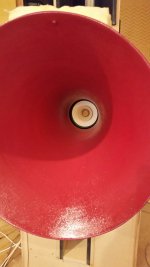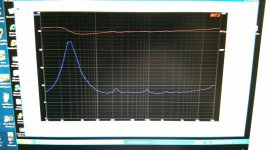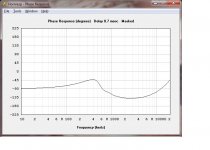Hi, I have a tractrix horn, which is coupled with 18 Sound ND1460A and it's group delay/impulse response measurements are quite poor. It overshoots a lot at lower frequencies. Basically below 2kHz is time unaligned. Horn's mouth is 58cm in diameter. I'm using it crossed at 500Hz with a 15" midbass driver but that doesn't matter since I've measured it with no crossovers at all. Tried it free standing, mounted on an open baffle, different positions of the microphone from close to the far field, it's always the same result.
Assuming both woofer and horn a minimum phase devices, you can make them (woofer and horn) phase coherent in the following way:
- determine the difference in excess phase between measurements of woofer and horn
- add delay to the woofer of physically shift the horn forward, such that the difference is zero
- add filtering to the woofer, such that its acoustical frequency response matches the target crossover low pass characteristic
- do the same with the horn to make it match the high pass characteristic
To check whether a system is minimum phase, it is easiest to look at the excess group delay ( = total group delay minus minimum group delay, the latter of which is calculated from the frequency response magnitude). Minimum phase systems have zero excess group delay; a constant value indicates a minimum phase device with an added delay. Make sure you only measure direct sound and no reflections, as the reflections make it non-minimum phase.
If I remember correctly woofers are minimum phase devices, but I have no idea how horns behave.
- determine the difference in excess phase between measurements of woofer and horn
- add delay to the woofer of physically shift the horn forward, such that the difference is zero
- add filtering to the woofer, such that its acoustical frequency response matches the target crossover low pass characteristic
- do the same with the horn to make it match the high pass characteristic
To check whether a system is minimum phase, it is easiest to look at the excess group delay ( = total group delay minus minimum group delay, the latter of which is calculated from the frequency response magnitude). Minimum phase systems have zero excess group delay; a constant value indicates a minimum phase device with an added delay. Make sure you only measure direct sound and no reflections, as the reflections make it non-minimum phase.
If I remember correctly woofers are minimum phase devices, but I have no idea how horns behave.
Last edited:
Maybe you didn't understand me.
I talk about the natural response of the driver and horn as a whole.
Here are measurements.
1. Free standing on a table:
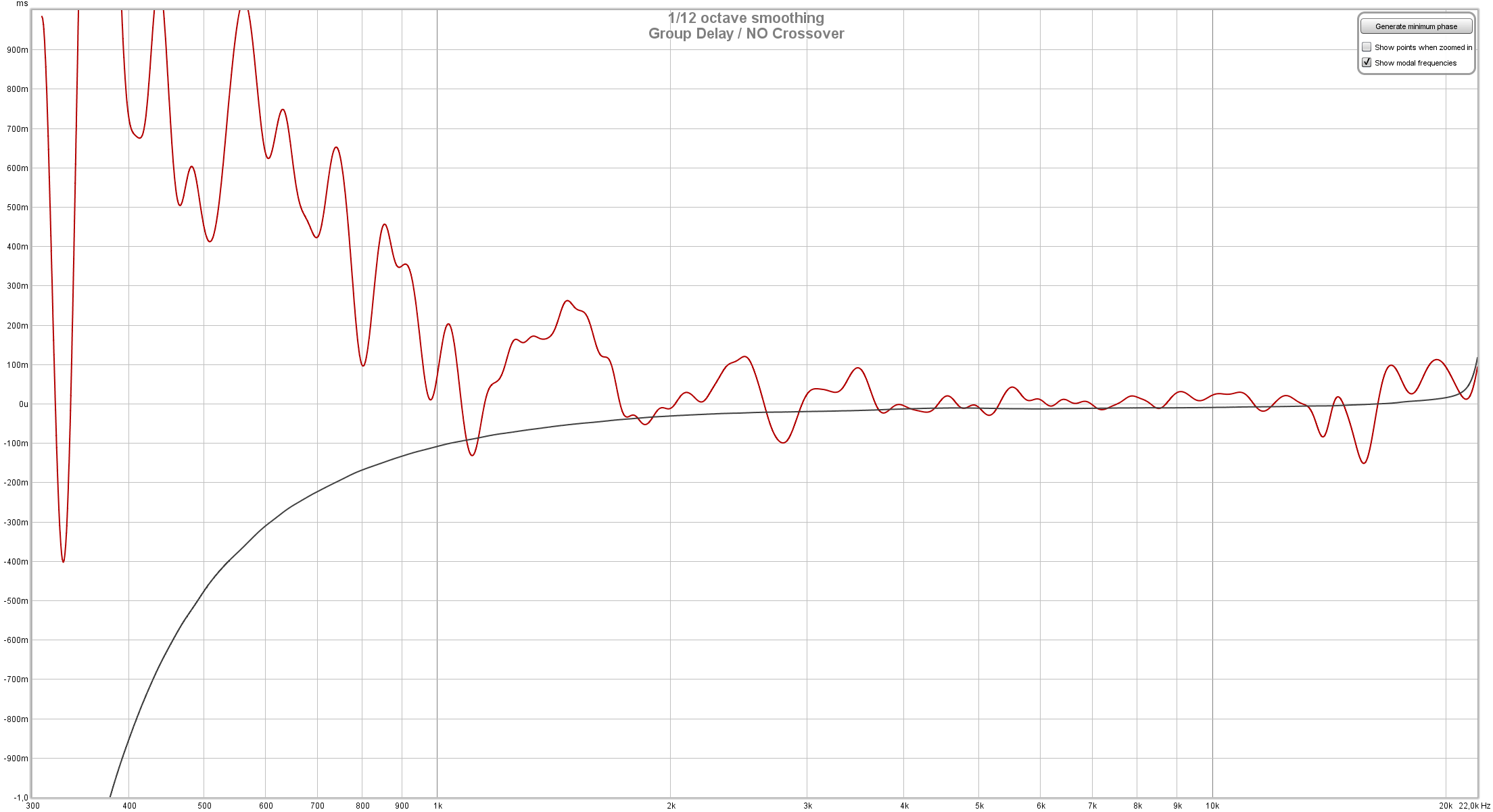
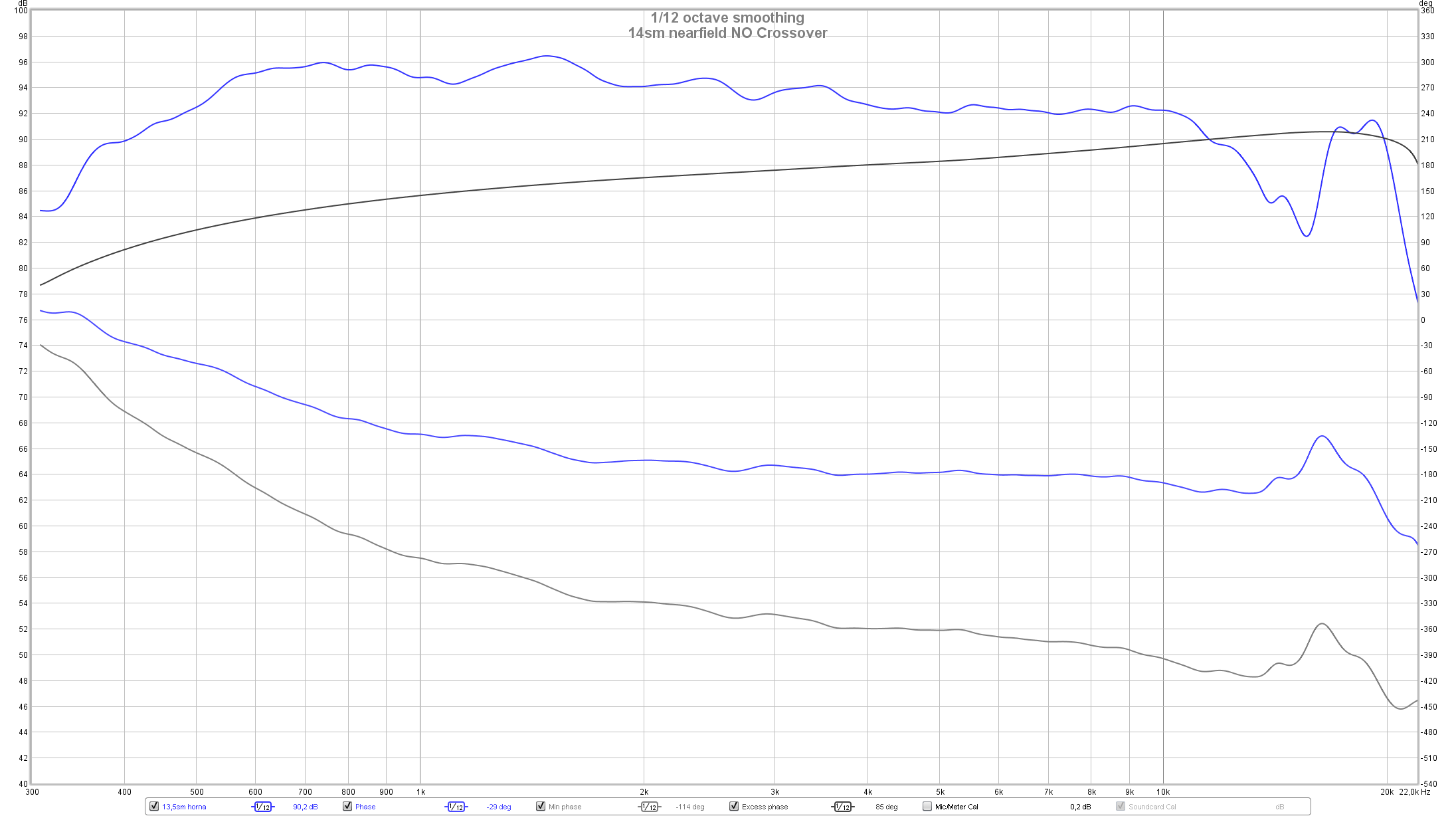
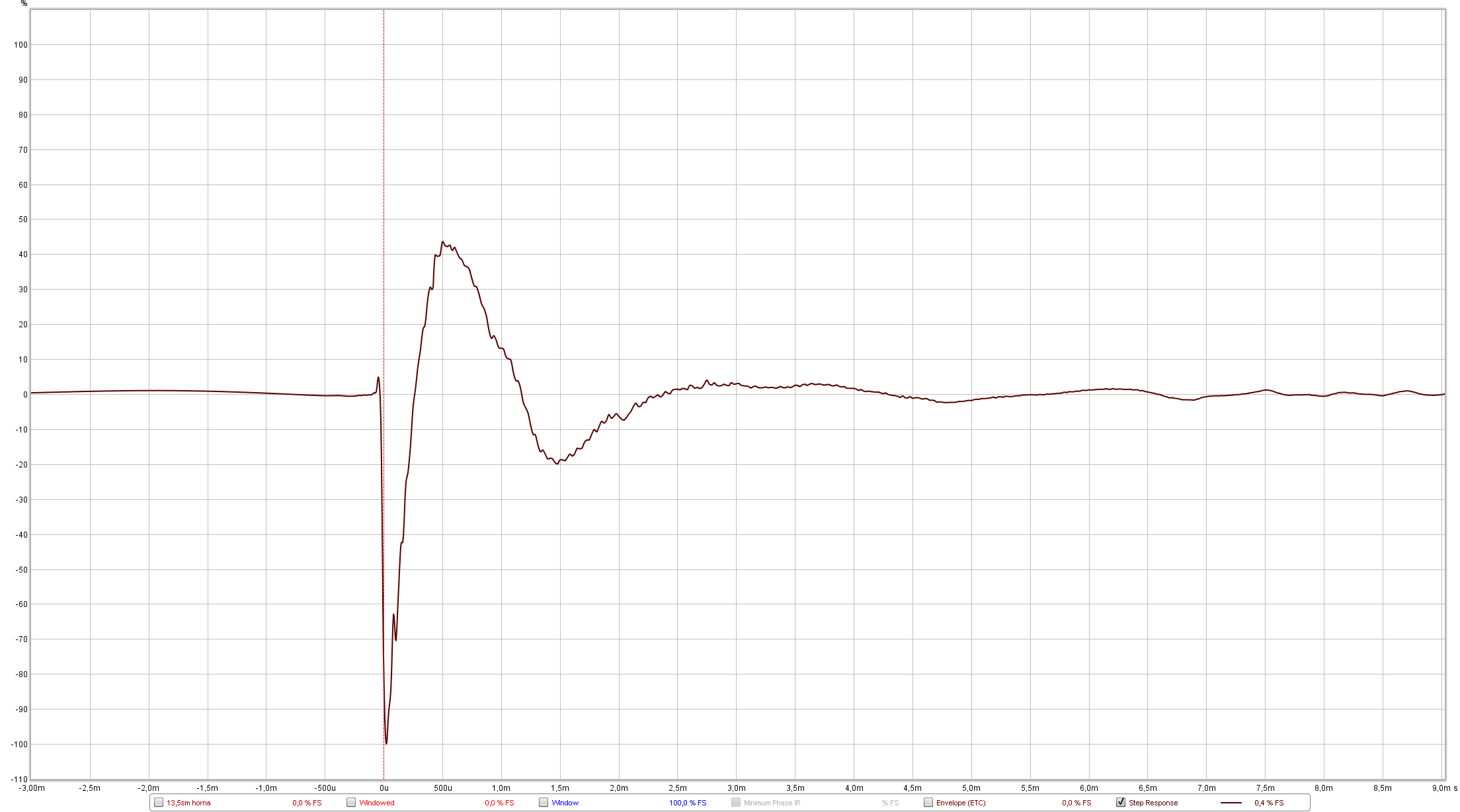
2. Half mounted on an open baffle:
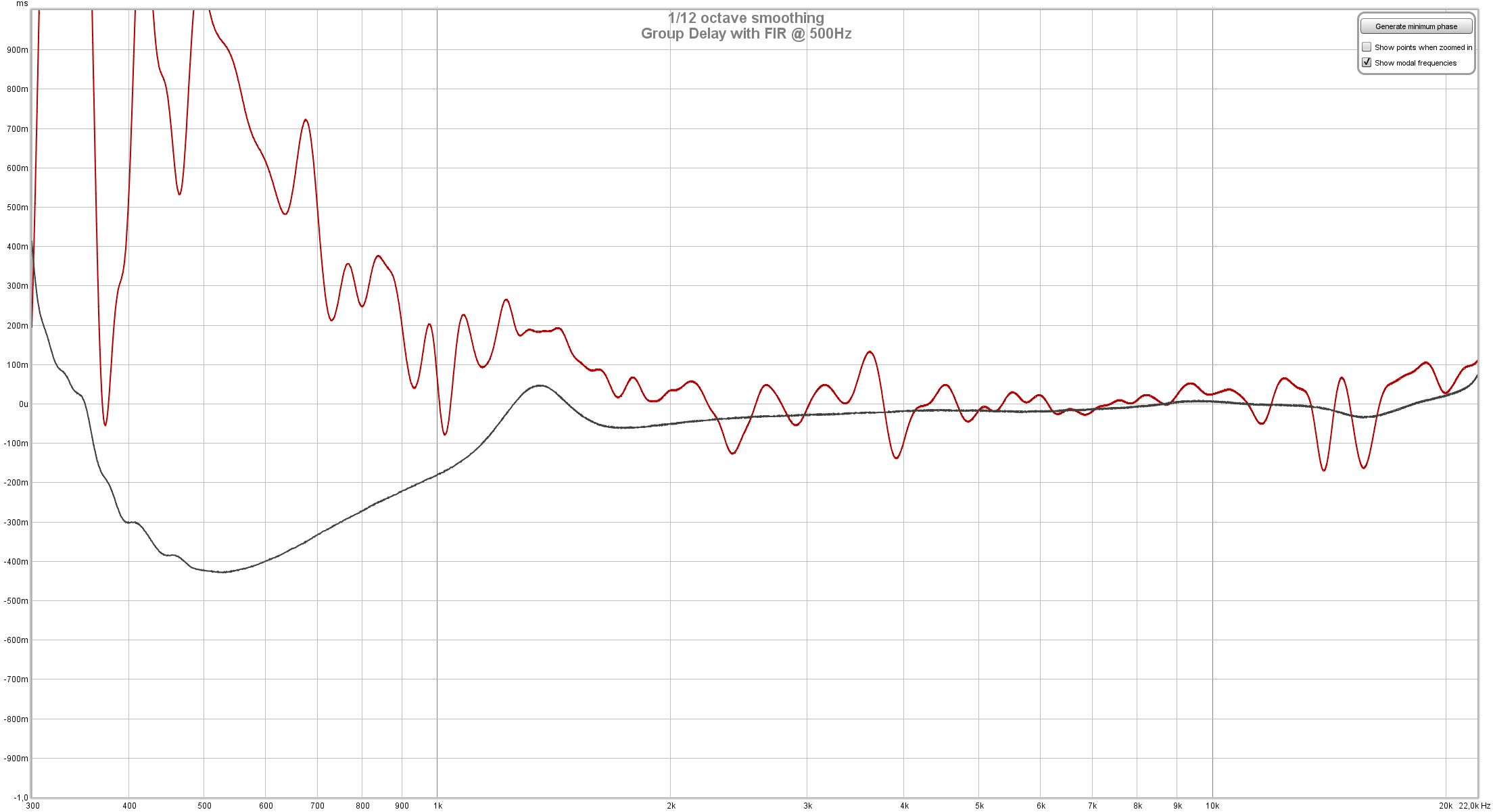
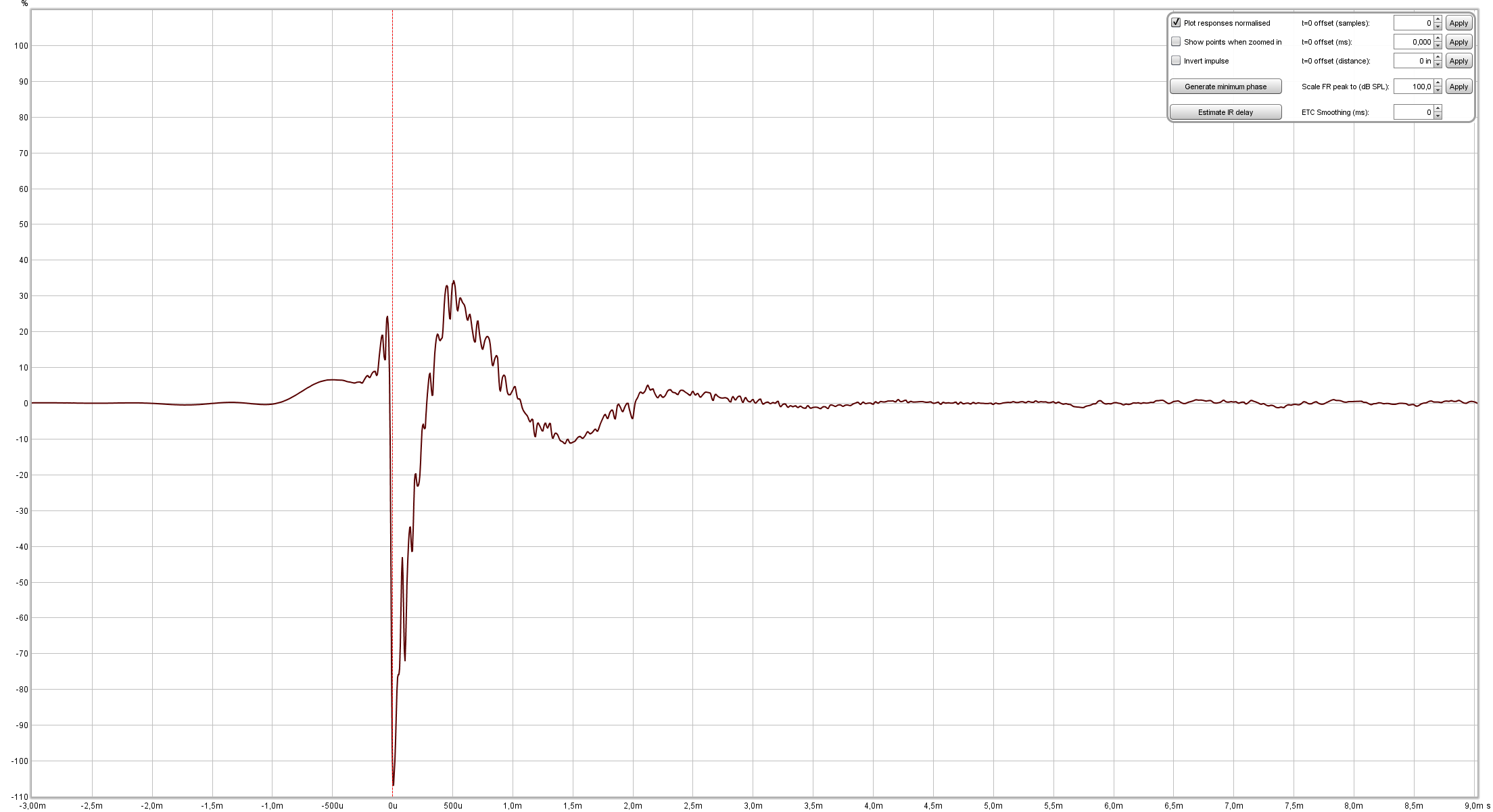
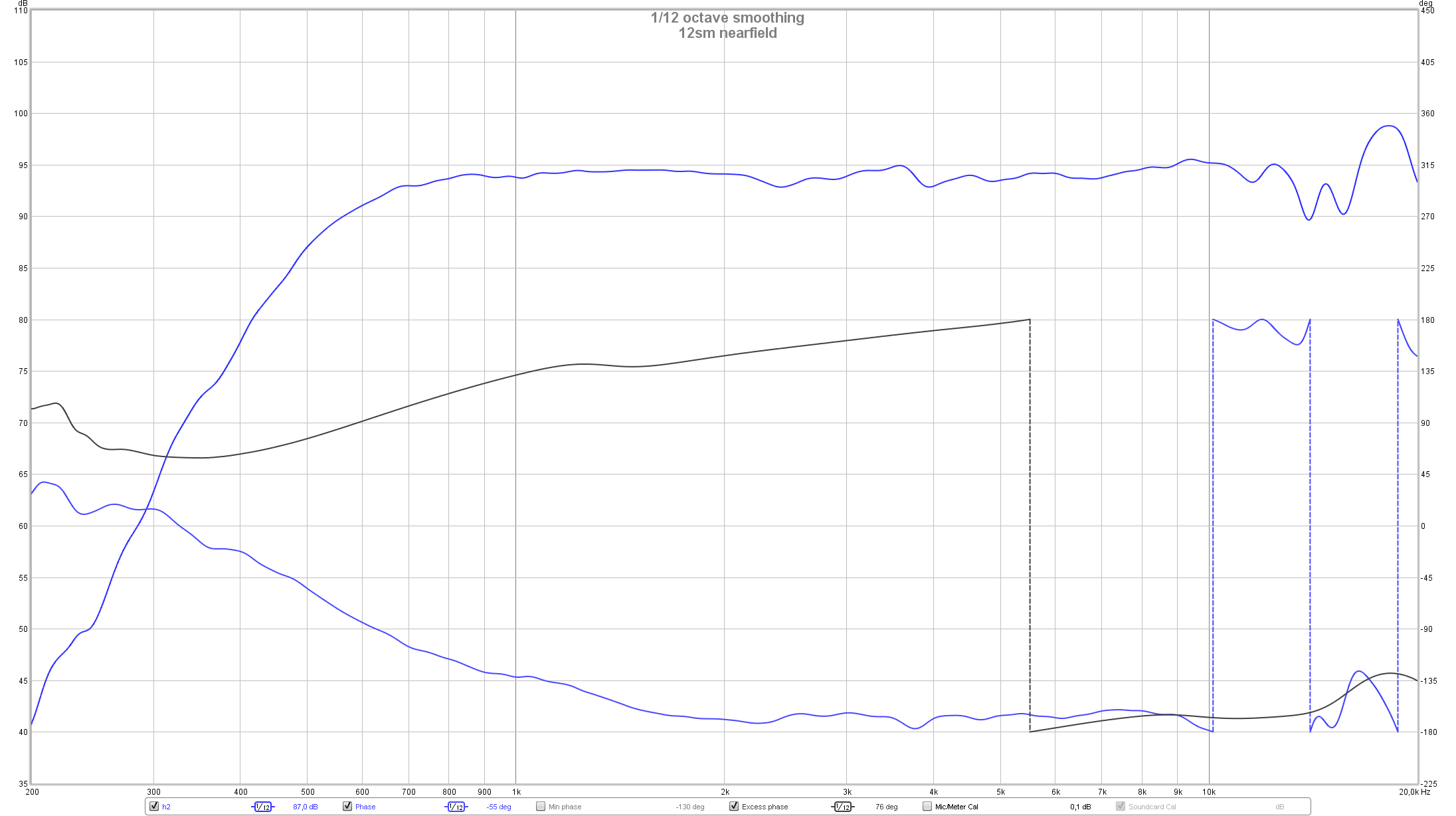
And one photo
http://images2.imagebam.com/27/58/ca/6d81a0907070704.jpg
I talk about the natural response of the driver and horn as a whole.
Here are measurements.
1. Free standing on a table:



2. Half mounted on an open baffle:



And one photo
http://images2.imagebam.com/27/58/ca/6d81a0907070704.jpg
Last edited:
No sense going to all that trouble unless you also go to your local dental supply store and buy dental impression goo. That way you can make a bite-board so your head will be stationary.
Don't forget to also buy a one-eared hearing protector (first decide which ear is to be the index) so you will not be troubled by sound arriving at both ears in erroneous phase.
Please correct me if I am wrong, but I thought today's received wisdom was that basic time alignment is helpful but no precision is needed beyond that, esp since no precision is possible... except as I have outlined above.
B.
Don't forget to also buy a one-eared hearing protector (first decide which ear is to be the index) so you will not be troubled by sound arriving at both ears in erroneous phase.
Please correct me if I am wrong, but I thought today's received wisdom was that basic time alignment is helpful but no precision is needed beyond that, esp since no precision is possible... except as I have outlined above.
B.
Last edited:
I think his issue is with achieving proper summing after being crossed-over. Or am I wrong ?
But basically a horn plus driver is a bandpass device and will therefore also have phase-shift at the lower (and higher) end of its passband. Is this what bothers you ? Unfortunately I can't open your images and the last link points to a porn site according to my content filter.
Regards
Charles
But basically a horn plus driver is a bandpass device and will therefore also have phase-shift at the lower (and higher) end of its passband. Is this what bothers you ? Unfortunately I can't open your images and the last link points to a porn site according to my content filter.
Regards
Charles
I understand what you're saying Vessk0 and I am not surprised at the results. Part of the problem is that the fast-opening horns like Tractrix are relatively short and do not load as much at the lower end of their band than a slower-opening horn. I also think modern drivers are not set up to be loaded purely by air-loading ( ie. horn ) at their lower extension - I think you would get a better result if you looked at eg. an Altec 288C on the same horn. How long is the horn ? You will not get proper horn-loaded behaviour ( ie. flat phase ) if the horn is not 1/2 wavelength at the lowest frequency of interest. The trade-off is to use a longer horn but this has the problem of it being a much bigger beast, or an undersized mouth with colouration issues.
Alongside building horns for upper mids and lower frequency, folded horns, I have also run a number of simulations of horns on Hornresp looking specifically at the phase behaviour rather than amplitude. You will find that something like a 425Hz Le Cleac'h for 1.4" throat is already losing phase coherence below 1000Hz , before allowing for any driver-related shortcomings.
Alongside building horns for upper mids and lower frequency, folded horns, I have also run a number of simulations of horns on Hornresp looking specifically at the phase behaviour rather than amplitude. You will find that something like a 425Hz Le Cleac'h for 1.4" throat is already losing phase coherence below 1000Hz , before allowing for any driver-related shortcomings.
He seems to be talking about just the driver/horn unit?
It's not possible to achieve phase "coherence" unless there are (minimum) two acoustic sources, so the premise of the thread is not even meaningful.
Some of these queries are difficult to decipher sometimes.
Dave.
This is just not correct. He's talking about the phase coherence of the driver/horn in its own operating band. Look at the last graph shown in the analysis above. The lower blue ( phase ) curve starts curving upwards below 2kHz. Above that frequency, it's flat to 15kHz.
Yes, it is correct.....depending upon how we define "coherence." I understand your explanation, but the reason I put "coherence" in quotation marks is because we're getting into semantics here. In my opinion, you need at least two, different acoustic sources (measured with a single microphone) to start applying the term "coherence" to anything.
I interpret the bottom graph as showing an approximate minimum-phase response associated with the amplitude drop-off at low frequency.
Dave.
I interpret the bottom graph as showing an approximate minimum-phase response associated with the amplitude drop-off at low frequency.
Dave.
If you want the group delay to be constant, the system must have linear phase. You can shift phase without affecting the amplitude by using FIR filters which you can design using RePhase. The phase response and impulse response will automatically also look neat, though it is questionable whether you can hear the difference. These FIR filters add delay, because without delay they would not be causal.
If the horns and woofer behave, you only have to undo the phase shift that is caused by the 500 Hz crossover. If delay is no objection, you could also correct the phase shift caused by the (acoustical + electrical) woofer high pass.
The raggedness of the non-nearfield measurements suggests that the microphone also captured reflected sounds. It is important that it does not capture reflections, otherwise the measured phase information will be off.
If the horns and woofer behave, you only have to undo the phase shift that is caused by the 500 Hz crossover. If delay is no objection, you could also correct the phase shift caused by the (acoustical + electrical) woofer high pass.
The raggedness of the non-nearfield measurements suggests that the microphone also captured reflected sounds. It is important that it does not capture reflections, otherwise the measured phase information will be off.
Last edited:
Much ado about very little (quite literally). I'm not sure that anyone has caught that he's showing microseconds delay in the vertical scale, not milliseconds:

Here are the Blauert & Laws group delay thresholds of audibility for humans--in milliseconds (i.e., 1000 times higher magnitude):

Considering that your compression driver is using an aluminum diaphragm coated with polymer, it actually looks pretty good for Al--especially up high. What is the OP's design criterion for group delay? (Below audibility threshold is mine.) However, the decay characteristics (ringing) seem to be much more apropos for more extensive scrutiny than group delay, IMO.
Chris

Here are the Blauert & Laws group delay thresholds of audibility for humans--in milliseconds (i.e., 1000 times higher magnitude):
Considering that your compression driver is using an aluminum diaphragm coated with polymer, it actually looks pretty good for Al--especially up high. What is the OP's design criterion for group delay? (Below audibility threshold is mine.) However, the decay characteristics (ringing) seem to be much more apropos for more extensive scrutiny than group delay, IMO.
Chris
Last edited:
+1. If we take the rather aged and isolated Blauert and Laws figures, at the worst, you need to be within a foot in alignment and at lower crossovers, maybe 3 feet.
I recall some posts about time alignment of subs - which can be far away from main speakers. There was some consensus that the best alignment we could achieve results in a slight tightening of the bass sound.
B.
I recall some posts about time alignment of subs - which can be far away from main speakers. There was some consensus that the best alignment we could achieve results in a slight tightening of the bass sound.
B.
Yes, it is possible
To answer the OP's question: Yes, it is possible. Note the red line in the attached graph. Very, very low phase variance.
Sorry for the poor image quality-- I had to take a picture of the screen, as the original file is too large to upload, here @ the DIY.
To answer the OP's question: Yes, it is possible. Note the red line in the attached graph. Very, very low phase variance.
Sorry for the poor image quality-- I had to take a picture of the screen, as the original file is too large to upload, here @ the DIY.
Attachments
Chris,Much ado about very little (quite literally).
Considering that your compression driver is using an aluminum diaphragm coated with polymer, it actually looks pretty good for Al--especially up high. What is the OP's design criterion for group delay? (Below audibility threshold is mine.) However, the decay characteristics (ringing) seem to be much more apropos for more extensive scrutiny than group delay, IMO.
Chris
I'm in agreement with you, just want to point out that the ND1460A, like many other designs, uses a diaphragm assembly composed of an aluminum dome with a proprietary treated polyester (Polyethylene/PEN) surround suspension.
The aluminum diaphragm is not "coated" with polymer, it is surrounded with polymer, which reduces sensitivity, but also reduces ringing and smooths response.
The aluminum diaphragm is not "coated" with polymer, it is surrounded with polymer, which reduces sensitivity, but also reduces ringing and smooths response.
Sounds similar to the Western Electric "ballpark" horn I used to have. But it was more advanced in having an edge-wound aluminum vc.
They were smart in 1940 (??).
B.
I don't believe the measured group delay curve - it looks like junk data - doesn't correspond to the data you get from a sim of any tractrix horn in the 200 to 400Hz range.Much ado about very little (quite literally). I'm not sure that anyone has caught that he's showing microseconds delay in the vertical scale, not milliseconds:
Chris
If you take the Op's data of a 1.4" throat, and 58cm mouth diameter it seems quite a big horn, cut-off frequency around 200Hz. The phase response shown in the above graphs is somewhat worse than the horn (alone) performance. Would be good to get more data.
Hi, I have a tractrix horn, which is coupled with 18 Sound ND1460A and it's group delay/impulse response measurements are quite poor. It overshoots a lot at lower frequencies. Basically below 2kHz is time unaligned. Horn's mouth is 58cm in diameter. I'm using it crossed at 500Hz with a 15" midbass driver but that doesn't matter since I've measured it with no crossovers at all. Tried it free standing, mounted on an open baffle, different positions of the microphone from close to the far field, it's always the same result.
Don't stress out, that is normal behavior. When a driver rolls off, the phase starts to rotate.
As another person in this thread observed, you can't evaluate the phase response without measuring at least two drivers.
IE, I wouldn't stress if the phase is off at 700hz when the tweeter alone is playing; I'd be stressed if there was a massive phase rotation at the xover point when BOTH drivers are playing.
Having said all that, it's going to be challenging to get the phase correct when the center-to-center spacing of the midrange and tweeter is 40cm:

Oh, and you don't want to measure phase at such a close distance. You want to measure it at a distance where you'll actually be listening. The phase curve will be all over the map at such a close distance.
As another person in this thread observed, you can't evaluate the phase response without measuring at least two drivers.
Oh no - this is awkward !
Here's the phase response of a 400Hz tractrix horn without a driver -
Should I contact David McBean to break the news gently that he's made a mistake ?
Attachments
- Status
- This old topic is closed. If you want to reopen this topic, contact a moderator using the "Report Post" button.
- Home
- Loudspeakers
- Multi-Way
- Is a horn phase coherent device?
